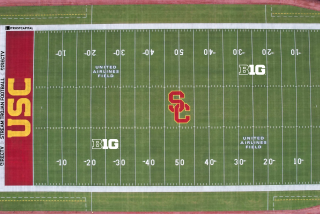Building Blocks : CS Northridge Prepares General Plan for Move to Division I, but Financing Looms as Obstacle to Face Lift for Facilities
- Share via
James Cleary, president of Cal State Northridge, tells a story he says illustrates why CSUN belongs in major college athletics.
It involves a conversation he overheard among a small group of fans from another college who were seated in the Northridge gym for a playoff game. They spoke of the expansiveness of the CSUN campus and wondered aloud what the school’s enrollment might be. Then they got the answer.
“Thirty thousand!” one cried. “What are they doing in Division II?”
Indeed, Cleary found it a difficult question to answer. Northridge was a major college in every other way, the president concluded, so why not in athletics? In April, he announced CSUN would join the NCAA’s Division I in all sports but football.
The move has been applauded by students and faculty as well as community boosters, but it is likely that Cleary hasn’t heard his last complaint. When he sits down to watch a Northridge basketball game two years from now, he might well hear someone again ask, “What are they doing in Division I?”
Possibly, that question will follow a Northridge turnover that results in a slam dunk. But it might also refer to the state of CSUN’s athletic facilities.
Bob Hiegert, CSUN’s athletic director, believes the school’s athletic facilities are adequate for Division II, and in some cases even for Division I. “But if you want to talk about the ideal situation--even in Division II--we have some work to do,” he said.
Basketball is expected to lead Northridge’s charge into big-time college athletics, yet there are no set plans to build an arena suitable for a major-college team. Instead, CSUN will continue to play in the Matador gymnasium, capacity 3,000, a home court similar to that of many high schools.
“Our gym right now is at best in the lower half of the ones in Division II,” Hiegert said. “At the Division I level, it would be very, very low.”
For now, however, Hiegert said he is content knowing the necessity for a 8,000-10,000-seat indoor arena has been acknowledged. “It took a long time before the need was recognized,” he said. “At least now there is a concerted effort to find land and a possible funding base.”
An equipment yard adjacent to the campus swimming pool already has been targeted as a potential site. Financing such a project--estimated cost is $10 million--presents a more formidable obstacle.
A referendum that would tax students for the construction is one possible solution. Hiegert said he will meet with student officers on a monthly basis after school begins regarding numerous subjects, including the proposal for an arena.
“I think the ability for students to have lectures and concerts and some kind of an indoor performing area on campus is more of a student concern than a university concern,” Hiegert said, implying that funds for the project would not likely come from the school’s budget.
State schools such as UC Davis and UC Irvine have financed arenas with student referendums. But Northridge administrators fear such a referendum might not pass because only last year CSUN students voted to impose a $25 per semester fee to pay for an expansion of student union facilities.
“The support here for athletics is significant and a referendum is not outside the realm of possibility, but the students already carry an extensive burden as it is viewed by some,” said Elliot Mininberg, CSUN’s vice president for administration and university advancement.
An alternative would be to use funds from the $150-million University Park development currently under construction on the North Campus.
University Park is a cooperative venture between the school and Watt Industries, Inc., a private developer, that will result in student dormitories, office buildings, conference rooms, a performing arts center, restaurants, a hotel and a 30,000-seat outdoor stadium. The entire development is being built over a 12-year period on a 100-acre site between Devonshire and Plummer streets and Zelzah and Lindley avenues.
Profits from the commercial parts of the project will underwrite the construction of university facilities.
An indoor arena is not part of the development’s current plans. That could change, but only at the expense of pushing back other construction, according to Charles Manley, CSUN’s director of facilities planning and operations.
Pete Cassidy, CSUN’s basketball coach, is lobbying for an arena, but not at the expense of delaying construction of a stadium.
“We could use both,” Cassidy said, “so to me it’s not an either-or proposition. If it is, then I would go with an arena, but I’m biased. All I will say is that if we’re going to be a Division I basketball program, then we must have an arena. I don’t feel we can be successful and competitive consistently unless we have an arena like the schools we’re recruiting against have.”
The outdoor stadium will be built first, school officials say, because North Campus Stadium, home to CSUN’s football and soccer teams, will be demolished in favor of a conference center, botanical garden and parking lots within University Park. Also, a larger stadium is needed for CSUN’s graduation. The school has been spending more than $100,000 a year in construction costs for temporary seating used only at commencement.
Completion of the stadium’s 10,000-seat first phase is still about five years away. The stadium will also house training and locker rooms, some classrooms and a weight room.
North Campus Stadium compares favorably with other Division II facilities for football, but Northridge lost a bid to host the national soccer playoffs last season because the facility was deemed unsafe by members of the NCAA site selection committee. They said the chain-link fence surrounding the field was too close to the field.
Plans call for the new stadium to be constructed on what is now a grassy area south of the baseball diamond’s right-field fence and north of the gym. The baseball and softball fields will be relocated slightly north of their present sites in order to make room for the stadium. After the move, lights will be added to both fields.
First on the list for renovation are the school’s athletic offices. Northridge has received preliminary approval for a $300,000 loan for the construction and furnishing of a 3,000-square-foot addition to the athletic administration building. School officials are hopeful that the cost--about $500,000, including interest, over a 10-year period--will be accommodated by fund-raising.
Hiegert says expanding the current office space was his top priority. “Right now we have no where to meet with potential fund-raising sources,” he said. “It is also important that we have a comfortable place for coaches to bring recruits.”
Construction on the offices should be completed by the end of the next school year.
Improvements on the individual athletic complexes will take much longer, and will depend largely on the success of University Park and the accuracy of revenue projections from the development.
The athletic department will be watching closely as the future success of its programs could hinge on the quality of its playing sites.
“The only way to be successful through the good and the bad times is to have athletic facilities on campus,” Hiegert said. “They are the solid base the program needs to grow and expand.
“Whatever University Park contributes as far as the building of a stadium is concerned is better than starting from ground zero. At least we’ll have something--anything--solid to build from. The arena, it’s a different story. You’re talking about starting from square one. It’s going to be a long struggle.”
More to Read
Get our high school sports newsletter
Prep Rally is devoted to the SoCal high school sports experience, bringing you scores, stories and a behind-the-scenes look at what makes prep sports so popular.
You may occasionally receive promotional content from the Los Angeles Times.







